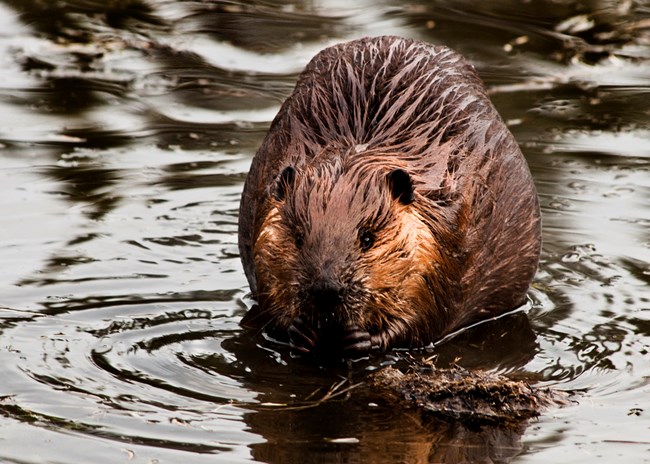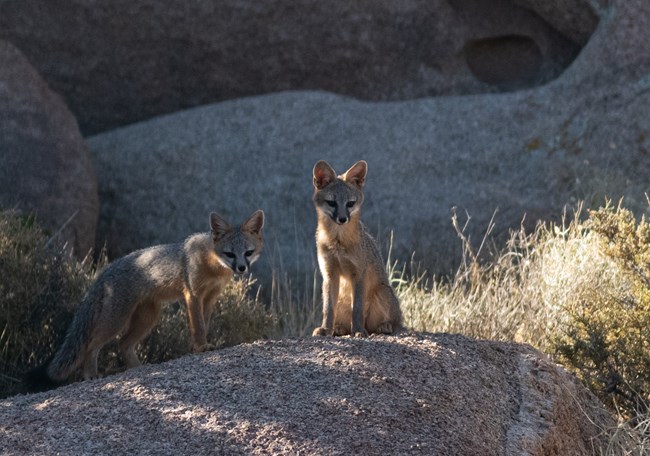|
The diverse geology of Capitol Reef provides diverse habitats for numerous plant and animal species. Fifty-eight mammal species have been documented in Capitol Reef National Park. This includes nineteen species of bats; other small mammals such as mice, woodrats, chipmunks; and large mammals such as deer, coyotes, and cougars. A complete Wildlife Checklist can be downloaded. The following highlights a few of the mammals of Capitol Reef: 
NPS / Nielson Desert Bighorn SheepThe desert bighorn sheep (Ovis canadensis nelsoni) is found in open, rocky areas of desert mountain ranges in the southwestern US, and is native to Utah. It was once common in the canyon country of southern Utah, and is widely depicted in rock markings left by early inhabitants of the area. Bighorn sheep disappeared from the Capitol Reef area presumably due to overhunting and disease. In the mid-1990's, 40 desert bighorn sheep from Canyonlands National Park were successfully reintroduced to Capitol Reef. Sheep are now commonly seen in areas south and east of Fruita including Grand Wash and Capitol Gorge. Another herd exists in the very southern end of the park. Sheep use steep cliffs and rugged, rocky terrain as escape routes to avoid predators. In the summer bighorn sheep typically eat grasses, while in winter they consume woody plants. They are primarily active during the day, with peak activity occurring during the early morning and late evening hours. 
NPS / Travis Lovell Mule DeerMule deer (Odocoileus hemionus) are found throughout western North America including Utah, where they occur in many types of habitat, ranging from open deserts to high mountains to urban areas. They typically migrate from high mountainous areas in the summer to lower elevations in the winter to avoid deep snow. As browsers, they feed on shrubs and other woody material, although grasses are also consumed. Mule deer are common residents in the Fruita area, and although they are habituated to humans, they are still wild animals that should not be approached or fed. 
NPS Mountain LionThe mountain lion (Puma concolor) is found in mountainous areas of the western US. It is fairly common throughout Utah, but individuals are rarely seen due to their secretive nature. They are active year-round, both day and night, although most activity occurs at dawn and dusk. A mountain lion's diet is composed primarily of large mammals such as deer and elk, but it will also feed upon rabbits, rodents, and other small mammals. These stealthy cats have been reported from various areas in Capitol Reef including Fruita where it preys upon mule deer and other mammals. Click here for more information on Mountain Lion safety. 
NPS / Chris Roundtree RingtailRingtails (Bassariscus astutus) inhabit the western US including most of Utah. They have been observed in the Fruita and Pleasant Creek areas of Capitol Reef. Ringtails prefer rocky desert and woodland habitats and their dens are typically located near water among rocks, in small caves, or in hollow logs. They are omnivores and consume small mammals, birds, reptiles, carrion, invertebrates, and fruits. While they are active year-round, their nocturnal and secretive behavior means they are seldom seen. Identifying characteristics are their long, bushy tail with distinct black and white bands, very large eyes, and pointed snout. They are very agile, moving with ease through tree tops or rocky canyons. 
NPS White-tailed Antelope SquirrelThe white-tailed antelope squirrel (Ammospermophilus leucurus), is found in the southwestern US. It is common in Utah where it inhabits desert and shrubland areas with sparse vegetation. In Capitol Reef it is abundant throughout the lower elevations and active year-round. It is most active during the day, although during hot weather it may only come out in the mornings and evenings. Its diet includes seeds, green vegetation, small vertebrates, insects, and carrion (animals already dead). When running, its tail is curled over its back exposing the white underside of the tail. 
NPS Rock SquirrelThe rock squirrel (Spermophilus variegatus) is found in the southwestern US including most of Utah. In the Fruita area, rock squirrels are abundant and can be identified by their gray color, relatively large size and long bushy tail. They prefer rocky habitats and construct their own burrows. A rock squirrel's diet consist of seeds, nuts, berries, green vegetation, roots, invertebrates, and even meat when it is available. They are active during the day, and only individuals at high elevations hibernate. This species is semi-social, usually occurring in loose groups consisting of a dominant male with several females and their young. 
NPS Yellow-bellied MarmotsThis large ground squirrel, also known as a rock chuck (Marmota flaviventris), is found in the western US and is common in higher elevations of Utah. It is abundant in the Fruita area and is commonly seen during its active season of mid-March through July. After feeding for a few months on the lush grasses and forbs in Fruita's orchards and fields, it retreats to its burrow to hibernate for the winter as early as August. In the heat of the summer, it is most active in early morning and late afternoon. Burrows are located under rocks and logs, in barren hillsides, and under buildings. Marmots typically live in small family groups although lone individuals are sometimes encountered. 
NPS American BeaverThe American beaver (Castor canadensis) inhabits streams, ponds, and small lakes across most of North America. In Capitol Reef, it lives along year-round streams and rivers including the Fremont River. Beavers are most well known for cutting trees to build dams, sometimes creating large ponds. Lodges of sticks and mud are often constructed near these ponds and used for shelter, food storage, and raising young. Along the Fremont River, beavers don't typically build dams or lodges, rather they construct dens in the river bank ("bank beavers"). One reason for not building dams and lodges in the Fremont is the high flow rate and perhaps the chance of flash floods that may undo all of the beaver's construction work. They eat bark, roots, and green aquatic and riparian vegetation. Sightings of beavers in Capitol Reef are rare but it's possible to see evidence of them along the river banks in the form of tracks and chewed and downed trees. 
NPS / Alessandra Puig-Santana Gray FoxThe gray fox (Urocyon cinereoargenteus) is found throughout much of the US. It is native to woodland and shrubland habitats of central and southern Utah and is common in the Fruita area of Capitol Reef. To identify a gray fox, look for a black stripe down the length of the tail and a black tip on the end. Like other canine species, gray fox are omnivores feeding on small mammals, insects, birds, fruits, and eggs. It is primarily nocturnal or crepuscular. Dens are usually located in small caves, hollows in logs or trees, beneath boulders, or in abandoned burrows of other animals. Although usually seen on the ground, gray fox are able to climb trees. 
NPS Canyon BatThe canyon bat or western pipistrelle (Parastrellus hesperus) is the smallest North American bat with a head and body length of less than 2 inches (0.80 cm). It is primarily found in the southwestern US including Utah where it inhabits desert and rocky habitats, always near water. It is commonly observed in Fruita and is typically the first bat seen flying in the evening, often before sunset. After 1 to 2 hours of feeding on small swarming insects it retires to a night roost in a cave, mine, rock crevice, or buildings, usually singly or in small groups. It may not be active again until near dawn. It hibernates during cold weather, but individuals do become active during warm spells in winter months.
Visit our keyboard shortcuts docs for details
A small group of Desert Bighorn ewes (females) in the snow along the Hickman Bridge Trail. |
Last updated: May 7, 2024
